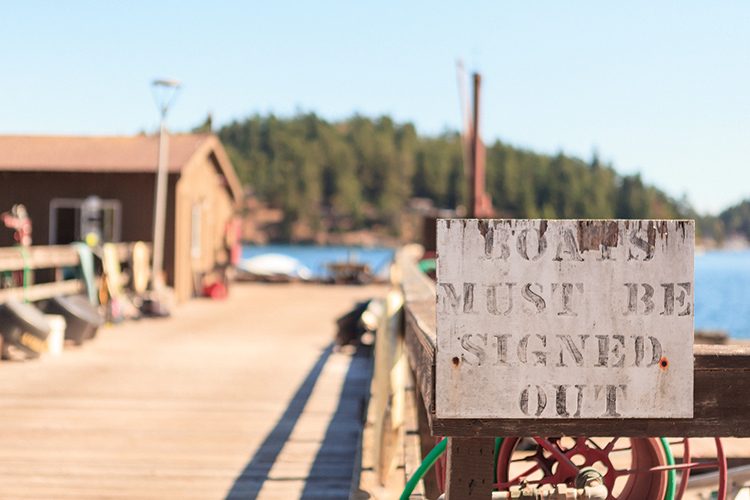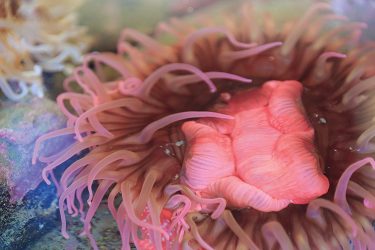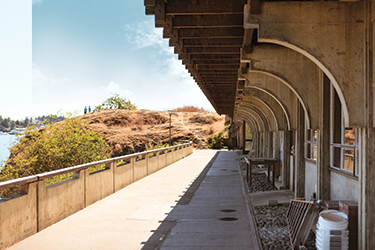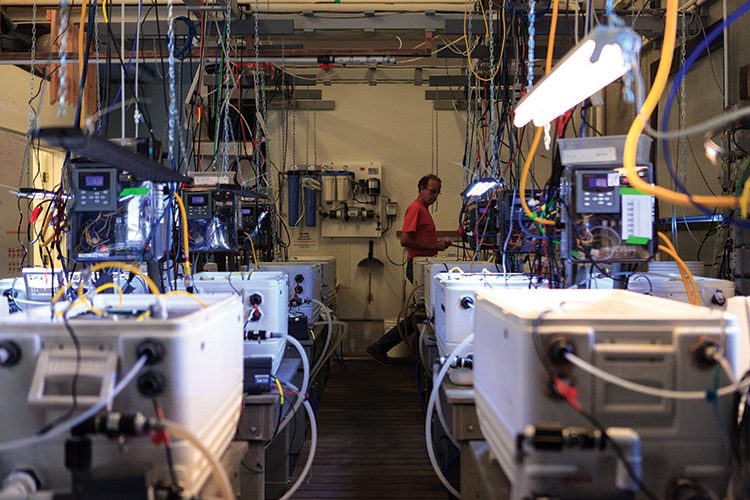Two summers ago, when word spread that a disease ravaged millions of sea stars along the Pacific Coast, Morgan Eisenlord donned her boots, grabbed a flashlight and headed for the beach.
“There was no time to waste,” says Drew Harvell, ’85, a Cornell University biologist who was doing her field work at UW’s Friday Harbor Laboratories. She and Eisenlord, ’13, a lab employee, went out at low tide to see if the local population of stars had been affected by the telltale lesions or were losing arms. “There was an outbreak near Vancouver and one in Southern California,” Harvell recalls. “We fully expected the sea stars to be sick.” To the scientists’ relief, the creatures were healthy.
Sea stars, which are echinoderms, usually have five arms, sometimes more. Hundreds of tiny feet help them cling to the rugged coast, shuffle along the sea floor and pry open their tasty prey. They come in delicious colors—oranges, reds, ochres, blues and purples. The sunflower star, a longtime resident of the subtidal waters around the Friday Harbor laboratory, can live up to five years, develop more than 20 arms and grow up to a meter across. It is a keystone predator in that ecosystem, eating clams, urchins, mussels and abalone.
“The subtidal sea stars, like the sunflower, are charismatic,” says Eisenlord. “They have very soft bodies and can move very quickly.” Now a Ph.D. student of Harvell’s at Cornell, Eisenlord returned to Friday Harbor last summer to continue her field research in one of the most diverse marine ecosystems in the country. There, she wondered why the stars, which were healthy a year before, were succumbing to a disease destroying their bodies. Did the disease mutate? Did the warmer ocean water play a role? As we sit in the 1920s dining hall at the marine station on quiet San Juan Island, Eisenlord draws my attention from our meal to tell me about the plight of the sea star.

Sea stars’ struggles are indicative of the changing oceans they call home.
While the disease skipped the San Juans in 2013, by the middle of the warm-water summer of 2014, scientists were seeing ochre and sunflower sea stars that were riddled with lesions and twisted limbs. “We saw large white areas that were just falling apart,” says Eisenlord. “You could see withered arms and dead animals.” And the worst cases? Those stars, she says, “looked melted.”
Eisenlord plucks her cell phone from her pocket to show me a picture, which makes me put down my fork. This disease absolutely decimated the population around Puget Sound and the Salish Sea, she says.
In the midst of all this mass mortality, scientists actually found an upside—they were able to collect data as it was unfolding. “A lot of disease happens out in the ocean and you never see it; you only see the aftermath,” Eisenlord explains. They found at least 20 species of sea star harmed by the outbreak. This is significant, scientists say, because losing sea stars could cause intertidal and subtidal ecosystems to change. The result? Fewer sea stars means more urchins, which will overgraze and turn healthy kelp forests barren. When Eisenlord and Harvell left Friday Harbor at the end of last summer, they wondered if they would ever see certain species of sea stars again.
Make no mistake, the sea is changing. Warming waters are causing some organisms to become more abundant, while undermining others’ ability to fight off disease. Invasive species, overfishing and mutated diseases are all signs and sources of changes to come. Increased acidity, whether from human activities like runoff and carbon emissions or from the upwelling of deeper waters, affects the ability of clams, oysters and fish to form shells and skeletons.
There is no place like the UW’s Friday Harbor Laboratories for scientists to explore these and other conditions. Not only does the area provide an incredible range of creatures to study, but UW marine experts explain that, due to higher acidity and wide fluctuations in pH and temperature, the Salish Sea is showing changes today that aren’t expected to appear in the ocean for another 100 years. “Ten years ago, we wouldn’t have known that,” says UW biologist Emily Carrington, who is studying coastal organisms and their responses to environmental fluctuations. She is in the process of making long-term measurements of weather and water conditions. “In retrospect, it’s really obvious,” she says. “To work at Friday Harbor is to look into the future of the ocean.”

Friday Harbor’s shallow beaches, mud flats and tidal areas are a marine scientist’s dream.
Finding Friday Harbor
In the early 1900s, Trevor Kincaid was not a happy man. He believed that the UW was neglecting marine science. The school’s only zoology professor, Kincaid enrolled at UW in 1894 to study insects, but he also collected seashells and boated around the Sound. “We dredged up a large amount of marine life, which gave me my first contact with innumerable forms of animal life that inhabit the deep water of Puget Sound,” Kincaid wrote in his 1962 autobiography. “The sea creatures I had read about or seen pictures of sprang to life before my eyes.”
If his students could share this experience, “it would vivify the subject. A live starfish is much more interesting than a specimen pickled in alcohol,” he wrote. While Columbia University and the University of Wisconsin had opened their own marine stations in the area, the UW seemed to be “sitting on its hands,” Kincaid noted.
In 1903, he convinced UW President Thomas Kane to open a marine lab. Kincaid toured the Puget Sound, visiting spots in Hood Canal and around Port Townsend. Then he detoured up to Friday Harbor, a small village on a sheltered deep-water bay on San Juan Island, about 100 miles north of Seattle. “I was amazed at the great wealth of animal life in that area,” Kincaid wrote. “In spite of its remoteness, it had many advantages over the other sites.” The UW’s marine lab opened there in 1904.
 During the lab’s rugged first few years, Kincaid, another scientist and a handful of students set up shop in an old cabin. Their laboratory was a long table under a tree; they cooked their meals over a campfire on the beach. They later moved into an idled fish cannery, then to a two-story building erected on piers over the water.
During the lab’s rugged first few years, Kincaid, another scientist and a handful of students set up shop in an old cabin. Their laboratory was a long table under a tree; they cooked their meals over a campfire on the beach. They later moved into an idled fish cannery, then to a two-story building erected on piers over the water.
Kincaid directed the station before turning his focus to oyster farming in Washington. The native oyster had been overfished and mismanaged; Willapa Bay’s once-thriving tideflats were wiped out. Kincaid proposed bringing the Pacific oyster from Japan to the region’s oyster beds, which helped save the industry. Meanwhile, the UW marine station had outgrown its site. In 1921, the U.S. government deeded the University about 480 wild acres on the north side of Friday Harbor’s U-shaped bay.
Harvell, who visited as an undergraduate, performed graduate work there in the 1980s, still returns regularly from Cornell to teach and conduct research. Why? Well, in Maine, there is only one species of a very small chiton (a primitive mollusk). “In Friday Harbor, there are at least seven or eight species,” she says. “And that’s true across the board—sea slugs, sea stars, any taxon [group of populations].”
Friday Harbor is also where creatures wash in from the outer coast. Organisms that move up from the south coast meet those sweeping down from the north. In 1990, the waters right around the marine station and up to 500 yards offshore were declared a state preserve, limiting what fishing and other possibly destructive activities might occur there.
Throw in the shallow beaches, mud flats, intertidal and subtidal areas, and you have a marine scientist’s dream, says Jan Newton, ’84, ’89, an oceanographer with the UW Applied Physics Laboratory. She leads the Northwest Association of Networked Ocean Observing Systems. This group coordinates data collected from sensors up and down the Washington and Oregon coasts, tracking harmful algae blooms, ocean acidity and coastal flooding. “We’re working on aligning the science along the West Coast,” she says. “Dial back 20 years and we only had a few ocean buoys. Now we have offshore buoys, mid-sound sensors and sensors near shore.”

Friday Harbor is pleasant in the summertime, but the UW’s marine lab there is busy year-round.
In addition to tracking the tides, Newton monitors the warm North Pacific gyre that flows here from Japan. She also keeps track of the upwelled cold and nutrient-rich water from below the continental shelf and the turbulent mixing of it all. “The San Juan Channel,” Newton says, “is like a great washing machine.” Because of this phenomenon, the area boasts two to three times as many species as those found along the coast. “We have all animal phyla here and we can show students things you can’t find in other places,” says lab director Billie Swalla. Experts from around the world travel here to study the beaches, dive into different ecosystems, collect data and specimens, and perform tests in the saltwater labs. These labs are in 13 buildings on the island hillside, fed by a web of black pipes that convey seawater to a series of tanks. Each building features its own set of wonders. Tubs and tanks burgeon with living creatures. In one room, a sea snail pokes its antennae over the edge of a small plastic tub while a reddish sea urchin skirts nearby.
In another building, dogfish circle in a large tank just feet from where biologist Adam Summers runs a 3-D printer that helps him explore the mechanical properties and swimming mechanics of fish, amphibians and reptiles. Down at the dock, the Centennial, a hulking research vessel, is primed to take students and scientists out to trawl, dredge or sample.
It’s no wonder that the Friday Harbor Laboratories regularly host so many visitors. Last summer, for instance, scientists from Denmark, Italy and Australia, as well as their students, shared a laboratory. In separate projects, they studied fish swimming patterns, behavior and response to predator attacks. “We have a hundred beds for students and a hundred beds for researchers and families,” says Swalla. “We’re busy all year round.”

The marine lab offers idyllic quarters for scientists.
Forming Attachments
Each spring, during the first few weeks in the life of the Pacific Northwest mussel, the tiny larvae swim in bays feasting on phytoplankton and algae, all while avoiding the hungry mouths of jellyfish and juvenile fish. They feed and then they cling—to rocks, to lines placed by mussel farmers, even to each other, to protect themselves from waves and predators. They form large clusters and knit themselves into place using secreted threads known as their byssus or beard.
About 30 miles south of Friday Harbor, in Whidbey Island’s Penn Cove, the folks running the nation’s oldest and largest commercial mussel farm are highly attuned to ocean change—and deeply concerned with how it might affect their yield as well as their profits. Laura Newcomb, a UW graduate student, is studying how well mussels raised here cling to their lines and what, in recent years, may be causing the shellfish to loosen their grip. At its worst, 20 to 30 percent of the mussels can tumble from the line on the way to harvest. The Penn Cove Shellfish Co. welcomed Newcomb’s study and invited her on the harvesting barge so she could collect specimens from different depths of the line. The growers told Newcomb when they had noticed an increase in nutrients or a change in seawater temperature that might affect the mussels’ growth and ability to attach. The growers also helped biologist Carrington’s team set up a sensor array on one of their rafts in the cove to record temperature and pH levels at different depths. But with the abundance of algae and the larvae’s eagerness to attach, it’s a challenge to keep the sensors clean, says Carrington.
Newcomb collected dozens of mussels and brought them into the new Ocean Acidification Environmental Laboratory at Friday Harbor, an experimental facility opened in 2011 with funding from the National Science Foundation, the UW and private donors. Carrington, the founding director, helped develop the facility. Here students and scientists can bring in organisms like mussels or algae and study how they respond in water with different chemistries. Large Igloo coolers serve as mesocosms—enclosed systems where chemistry, temperature and light can be controlled. Wires and chains tentacle from a trellis above, carrying power, light and measuring tools into each specific zone. An adjacent analytical chemistry room allows the researchers the rare opportunity to collect reliable measurements just feet away from their experiments.
“Historically we did a lousy job of monitoring the environment. Now we’re doing much better.”
Emily Carrington, UW biologist
“Only a few labs in the country have this type of state-of-the-art equipment for ocean chemists and biologists,” says Carrington. “And ours is the only one that also has a teaching mission.” Tests in the Ocean Acidification Lab can run a few hours, a few days or even a few weeks.
Behind the lab, a narrow trail runs alongside the pipes carrying seawater into the station. Carrington leads us on a quick hike along the bay. Just past the pump house, she proudly rests her hand on the metalwork of her weather station. She can gauge wind, humidity, even nighttime cloud cover. A few feet away, another set of sensors dip down into the water to gauge tide and temperature. “Historically we did a lousy job of monitoring the environment,” she says. “Now we’re doing much better.”
Carrington has managed to keep measurements since 2005. Her data reveals fluctuations in salinity and temperature—critical findings that surprised many longtime researchers.
Last spring, Professor Emeritus James Murray, who specializes in ocean chemistry, wrote about some of these results, noting that the area around the lab, and many other regional coastal areas, contained higher levels of acidity than the ocean, which could cause the ecology to change more quickly. The conditions around Friday Harbor make it an ideal place to study how different organisms respond and adapt, or how they don’t, says Carrington, a co-author on the paper.
Time at Friday Harbor will help scientists develop a clearer picture of how sea life might respond to warmer, more acidic ocean water. Will some creatures thrive and others disappear? As to why Penn Cove mussels have weaker attachments at different times, “Our newest measurements,” Carrington says, “suggest that temperature is playing a role.”

The Ocean Acidification Lab.
Floating Inspiration
It was 1961. Flat out of ideas, Osamu Shimomura climbed into a rowboat to escape his colleagues at Friday Harbor and quiet his mind.
The scientist was in hot pursuit of the Aequoriea victoria jellyfish. Working for a Princeton University lab, his job was to collect the gelatinous marine animal and figure out how to isolate a bioluminescent protein from it. The Friday Harbor lab was the place to do it, he noted. “A constant stream of floating jellyfish passed along the side of the lab dock every morning and evening, riding with the current,” he wrote of his experience. In their first days, he and his colleagues struggled to isolate the luminescent substance that rimmed the jellyfish’s umbrella. They soon exhausted all of their ideas. So Shimomura spent days “soul searching” while drifting under the summer sky. “Friday Harbor in summer, at that time, was quiet and peaceful,” he wrote.
There, in the middle of the bay, in the middle of an afternoon, it came to him: The enzyme or protein responsible for lighting up might be affected by a change in pH. He rushed back to the lab, set up an experiment and found he was right. But his big discovery was yet to come. When he threw his experiment into a sink where a seawater tank was draining, the light flashed even brighter. At that point, Shimomura realized calcium was the key.
Returning every summer over two decades, he and his team acquired at least 3,000 jellies a day—enough to supply his research and provide the groundwork for isolating the glowing matter the following year.
Shimomura ultimately discovered the proteins aequorin and green fluorescent protein, the latter now a tagging tool that allows researchers to see things like the development of nerve damage or the spread of cancer cells. That discovery earned him a share of the 2008 Nobel Prize in Chemistry.
Future and Fate
Last spring, Harvell and Eisenlord returned to Friday Harbor hoping to find sea stars that had survived the devastating disease. “The numbers were way down, but we saw healthy ochre stars [the five-armed intertidal stars] in the spring,” says Harvell. “Then wasting disease increased again later in the summer. And sadly, we’re not seeing the sunflower at all in the San Juans, and it’s no better in California.”
The sea star has become symbol for the urgency of understanding ocean change. “The only thing that has been gratifying about this is the level of public interest,” says Harvell. “The people living around Washington and the Pacific Northwest really value their marine resources, and are on top of understanding their issues.”
Just two years ago, visitors to the lab could simply walk out onto the dock and glimpse the bright orange and yellow stars in the clear waters below. This year, even their ghostlike remains are gone.